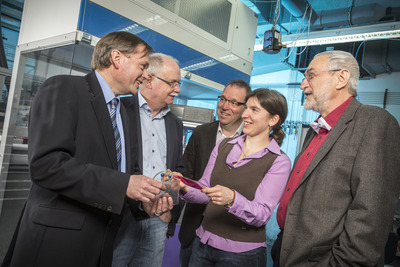Adherent cell cultivation is in the bag
How do you alter the inside of a closed bag without opening it? It’s not a trick question, as researchers in Braunschweig, Germany, have achieved just that.
Led by Dr Kristina Lachmann and Dr Michael Thomas of the Fraunhofer Institute for Surface Engineering and Thin Films (IST), the interdisciplinary team used plasma flashes to activate the inner surfaces of plastic bags. The plasma acts as a disinfectant while also transforming the surface of the bag so the human cells contained within can be cultured under sterile conditions.

“Our goal was to realise a closed system in which cells grow undisturbed and without the risk of contamination,” said Dr Henk Garritsen from Braunschweig Municipal Hospital. “Coating the bags with plasma enables us to use them as a GMP (good manufacturing practice) laboratory.”
Cells are grown in order to help fight disease; leukaemia, for example, can be treated using the patient’s or a donor’s stem cells. But culturing such cells is a highly involved process as they have to be cultured in the same way that drugs are produced: under GMP conditions. Typically, this requires the use of specialised lab equipment such as Petri dishes, bottles and bioreactors in a sterile environment.
But even then, these systems have to be opened in order to refill culture media or extract cells. This frequently leads to contamination, threatening the health of the patient and rendering the cells useless.
At the Helmholtz Centre for Infection Research (HZI), Dr Werner Lindenmaier and Dr Kurt Dittmar were already working on bags for cultivating stem cells, but without success. They learned of the Fraunhofer IST researchers - and their expertise in plasma coating - and the two teams came together. Initial tests showed that the cells could grow on plasma-coated films, and a joint project sponsored by the German Federal Ministry of Economics and Technology set out to investigate the closed bag system and cell growth in greater detail.
The key part of the method is coating with plasma. To achieve this, ordinary bags such as those used for blood transfusions and IVs were filled with a noble gas and voltage was applied. “This produces plasma inside the bag for a short period - a luminous, ionised gas that chemically alters and at the same time disinfects the surface of the plastic,” explained Dr Lachmann. It also means that human cells are able to grow adherently inside the bag.
The bags were coated in a pilot plant at Fraunhofer IST, and then tests were carried out at HZI and Braunschweig Municipal Hospital to determine which coating was best suited for which type of cell.
“Through slight modifications during the process of production, we were able to adapt the bag system to other types of cells,” said Dr Dittmar. “We’ve already succeeded at culturing bone, cartilage and even neural tissue stem cells inside the bag.”
Furthermore, explained Dr Lindenmaier, the bag does not need to be opened in order to supply the cells with nutrients. “Instead, cells and the nutrient medium can be introduced into the bag using a special protocol called ‘sterile docking’.” Thus, bacterial contamination essentially becomes a non-issue.
Now the pilot plant’s individual coating steps have been optimised, making it possible to manufacture standardised and reproducibly modified bags for cell cultivation. Dr Thomas noted that before the process can be approved for clinical use, it must be demonstrated to be innocuous.
For their efforts, the team recently received the Fraunhofer Society’s highly renowned Award for Human-Centered Technology, worth €50,000.
Antibody treatment reprograms immune system after heart attack
A new drug being trialled in heart attack patients could reprogram the immune system to prevent...
Nanoparticles supercharge vinegar's wound-healing power
Adding microscopic particles to vinegar can make them more effective against dangerous bacterial...
Not all brown snake venoms are alike, causing antivenom concerns
Venom from northern and southern populations of eastern brown snake builds blood clots in very...



